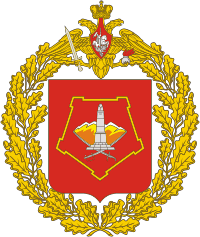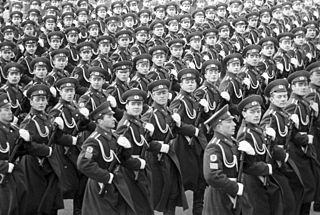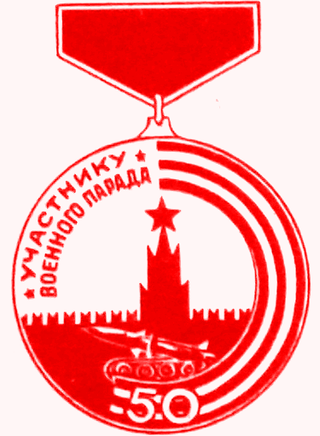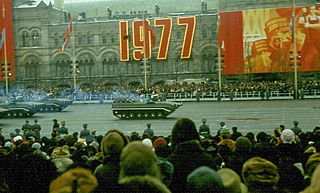Before the parade commenced the then General Secretary of the All-Union Communist Party of the Soviet Union (Bolsheviks) and Premier of the USSR Joseph Stalin delivered the following address to the nation: [5]
"Comrades, men of the Red Army and Red Navy, commanders and political commissioners, working men and working women, collective farmers-men and women, workers in the intellectual professions, brothers and sisters in the rear of our enemy who have temporarily fallen under the yoke of the German brigands, and to our valiant men and women guerillas who are destroying the rear of the German invaders!
On behalf of the Soviet Government and our Bolshevik Party, I am greeting you and congratulating you on the twenty-fourth anniversary of the Great October Socialist Revolution.
Comrades, it is in strenuous circumstances that we are to-day celebrating the twenty-fourth anniversary of the October Revolution. The perfidious attack of the German brigands and the war which has been forced upon us have created a threat to our country. We have temporarily lost a number of regions, the enemy has appeared at the gates of Leningrad and Moscow. The enemy reckoned that after the very first blow our army would be dispersed, and our country would be forced to her knees. But the enemy gravely miscalculated. In spite of temporary reverses, our Army and Navy are heroically repulsing the enemy’s attacks along the entire front and inflicting heavy losses upon him, while our country—our entire country—has organized itself into one fighting camp in order, together with our Army and our Navy, to encompass the rout of the German invaders.
There were times when our country was in a still more difficult position. Remember the year 1918, when we celebrated the first anniversary of the October Revolution. Three-quarters of our country was at that time in the hands of foreign interventionists. The Ukraine, the Caucasus, Central Asia, the Urals, Siberia and the Far East were temporarily lost to us. We had no allies, we had no Red Army—we had only just begun to create it; there was a shortage of food, of armaments, of clothing for the Army. Fourteen states were pressing against our country. But we did not become despondent, we did not lose heart. In the fire of war we forged the Red Army and converted our country into a military camp. The spirit of the great Lenin animated us at that time for the war against the interventionists. And what happened? We routed the interventionists, recovered all our lost territory, and achieved victory.
To-day the position of our country is far better than twenty-three years ago. Our country is now many times richer than it was twenty-three years ago as regards industry, food and raw materials. We now have allies, who together with us are maintaining a united front against the German invaders. We now enjoy the sympathy and support of all the nations of Europe who have fallen under the yoke of Hitler’s tyranny. We now have a splendid Army and a splendid Navy, who are defending with their lives the liberty and independence of our country. We experience no serious shortage of either food, or armaments or army clothing. Our entire country, all the peoples of our country, support our Army and our Navy, helping them to smash the invading hordes of German fascists. Our reserves of man-power are inexhaustible. The spirit of the great Lenin and his victorious banner animate us now in this patriotic war just as they did twenty-three years ago.
Can there be any doubt that we can, and are bound to, defeat the German invaders?
The enemy is not so strong as some frightened little intellectuals picture him. The devil is not so terrible as he is painted. Who can deny that our Red Army has more than once put the vaunted German troops to panic flight? If one judges, not by the boastful assertions of the German propagandists, but by the actual position of Germany, it will not be difficult to understand that the German-fascist invaders are facing disaster. Hunger and impoverishment reign in Germany to-day; in four months of war Germany has lost four and a half million men; Germany is bleeding, her reserves of man-power are giving out, the spirit of indignation is spreading not only among the peoples of Europe who have fallen under the yoke of the German invaders but also among the German people themselves, who see no end to war. The German invaders are straining their last efforts. There is no doubt that Germany cannot sustain such a strain for long. Another few months, another half-year, perhaps another year, and Hitlerite Germany must burst under the pressure of her crimes.
Comrades, men of the Red Army and Red Navy, commanders and political instructors, men and women guerillas, the whole world is looking to you as the force capable of destroying the plundering hordes of German invaders. The enslaved peoples of Europe who have fallen under the yoke of the German invaders look to you as their liberators. A great liberating mission has fallen to your lot. Be worthy of this mission! The war you are waging is a war of liberation, a just war. Let the manly images of our great ancestors—Alexander Nevsky, Dmitry Donskoy, Kuzma Minin, Dmitry Pozharsky, Alexander Suvorov and Mikhail Kutuzov—inspire you in this war! May the victorious banner of the great Lenin be your lodestar!
For the complete destruction of the German invaders! Death to the German invaders!
Long live our glorious Motherland, her liberty and her independence!
Under the banner of Lenin, forward to victory!"

















